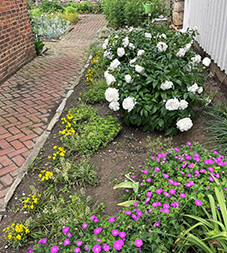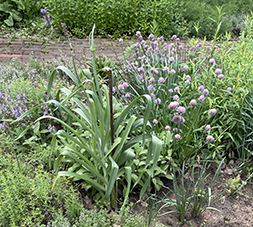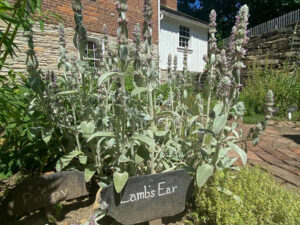Published August 16, 2024
Rooted in Tradition
 Spilling out at the bottom of a steep hill and nestled against the Gov. Hendricks House, there’s a three-in-one pharmacy, pantry and sanctuary growing at Corydon Capitol State Historic Site.
Spilling out at the bottom of a steep hill and nestled against the Gov. Hendricks House, there’s a three-in-one pharmacy, pantry and sanctuary growing at Corydon Capitol State Historic Site.
This is the site’s historic herb garden, budding and blooming with nearly 30 different plants over the course of the year.
Established by the family of Civil War hero and community fixture Judge William Porter, the flora you’ll find on your tour of the garden is extremely close to what the Porters would have grown there when they planted it around 1848.
Most 19th-century families would have had an herb garden, commonly known as a kitchen garden, where they would grow plants for seasoning food, medicinal remedies and teas. But the Porters took their garden up a notch, turning it into a “potager” — an herb garden with flowers, purely because they looked pretty.
 “As you can imagine, there was no ‘McCormack spice aisle’ anywhere, or even truly a grocery store in 1841 in Corydon when the garden was first established,” said Kelly Hanna-Carroll, site manager at Corydon Capitol. “So ready access to herbs to season foods and make helpful folk remedies was more of a necessity than a luxury.”
“As you can imagine, there was no ‘McCormack spice aisle’ anywhere, or even truly a grocery store in 1841 in Corydon when the garden was first established,” said Kelly Hanna-Carroll, site manager at Corydon Capitol. “So ready access to herbs to season foods and make helpful folk remedies was more of a necessity than a luxury.”
And the Porters had a fantastic spice cabinet, growing basil, sage, French tarragon, parsley, winter savory, borage, Merigolds, nasturtium, Viola-Johnny Jump Up and red carpet thyme.
When someone felt under the weather, the Porters had a wide selection of herbal remedies to draw from. A sore throat could be soothed by red carpet thyme or Doonesbury thyme. Catnip and horehound could alleviate stomach problems and indigestion, and pennyroyal helped with common colds, pneumonia and breathing problems. And if you had a bad cough, anise hyssop tisane could suppress it.
 They also grew peonies (the state flower), orange marigolds, santolina, lamb’s ear, sweet woodruff, yellow violas, annual marble gray pelargoniums and pumpkins in the fall.
They also grew peonies (the state flower), orange marigolds, santolina, lamb’s ear, sweet woodruff, yellow violas, annual marble gray pelargoniums and pumpkins in the fall.
This garden has so many stories below the topsoil, including those of the people who took care of it, the connection between the plant labels and so much more. Be sure to ask your tour guide about it during your next visit.









